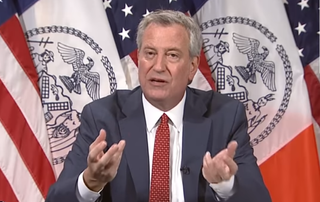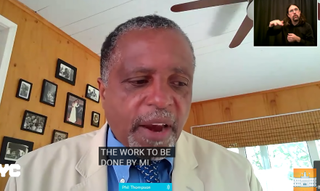New York Will Take NYPD Money to Help Close Digital Divide
New York Mayor Bill DeBlasio will be taking money from the "thin blue line" to help end digital "redlining" by building out municipal broadband, including training young people (and adults) to "install and operate" network infrastructure.

DeBlasio said one of major steps the city needs to take as it reopens services during the COVID-19 pandemic and tries to build back a better city is to close what he said is a "very, very intense" digital divide, and he is proposing to put the city's money where that divide is.
He said 1.5 million New Yorkers lack home broadband access and that it was something the city had to tackle head on. In fact he said it was a tale of two cities, the haves and the have nots, divided by the profit motive. He said ISPs "had not attended to lower-income communities and "not done what has been asked of them to "really, truly, fairly, equally make sure that everyone has access."
He said what the ISPs had done was not fair or respectful of communities.
The city has already sought and gotten expressions of interest for internet service options, including "new products and pricing, new service choices with discounted rates for public housing residents, free WiFi solutions that residents can reach from their homes, or other innovative approaches employing established or emerging technologies."
He said the city's internal Task Force on Racial Inclusion and Equity has taken up the issue to make big structural changes quickly and, to that end, the city would spent $157 million to end what he called digital redlining and provide high-speed internet, taking $87 million of that from the NYPD to go for broadband in low-income housing.
He says the money will go to "new service options" for 600,000 "underserved" New Yorkers, which means overbuilding existing plant, either because the speed or the price is considered an impediment to access, update of full digital citizenship. He said the money will be building a path toward universal broadband for the city.
Multichannel Newsletter
The smarter way to stay on top of the multichannel video marketplace. Sign up below.
“COVID-19 has further exposed the inequalities in internet access while changing the way New Yorkers work, learn, and live. Accelerating universal broadband access will make our city healthier, safer, and more equal," DeBlasio said.

"Not having access to the internet in 2020 is like not having access to public education in 1950," said Deputy Mayor and task force co-chair Phil Thompson. He said the internet is a necessity, not a convenience, and that the digital divide makes the racial divide even greater.
He said the $157 million initiative will expand low and no-cost access within 18 months. He said much of the buildout will be done by minority and women-owned businesses and nonprofits. "We cannot claim to be a fair city or a Democratic city when people are denied access to the internet becuase they don't have enough money to afford it or because big corporations don't make enough money providing service."
DeBlasio also said he would fight for a state law to charge ISPs for use of the New York City streets because they were "profiting but not paying their fair share." That money would go so subsidize low-cost broadband to those underserved communities.
Shrihari Pandit, CEO of Stealth Communications, which provides high-speed internet access in the city, begs to differ with the suggestion ISPs don't already pay for street access. He ticked off franchise fees of $500,000 plus .25 cents per foot per cable per quarter (plus CPI adjustments). Then there is NYC's special property tax on cable in the streets (14% annually, he says), plus conduit rental fees, though they are to Verizon or others, plus Department of Transportation permit fees.
Contributing editor John Eggerton has been an editor and/or writer on media regulation, legislation and policy for over four decades, including covering the FCC, FTC, Congress, the major media trade associations, and the federal courts. In addition to Multichannel News and Broadcasting + Cable, his work has appeared in Radio World, TV Technology, TV Fax, This Week in Consumer Electronics, Variety and the Encyclopedia Britannica.

